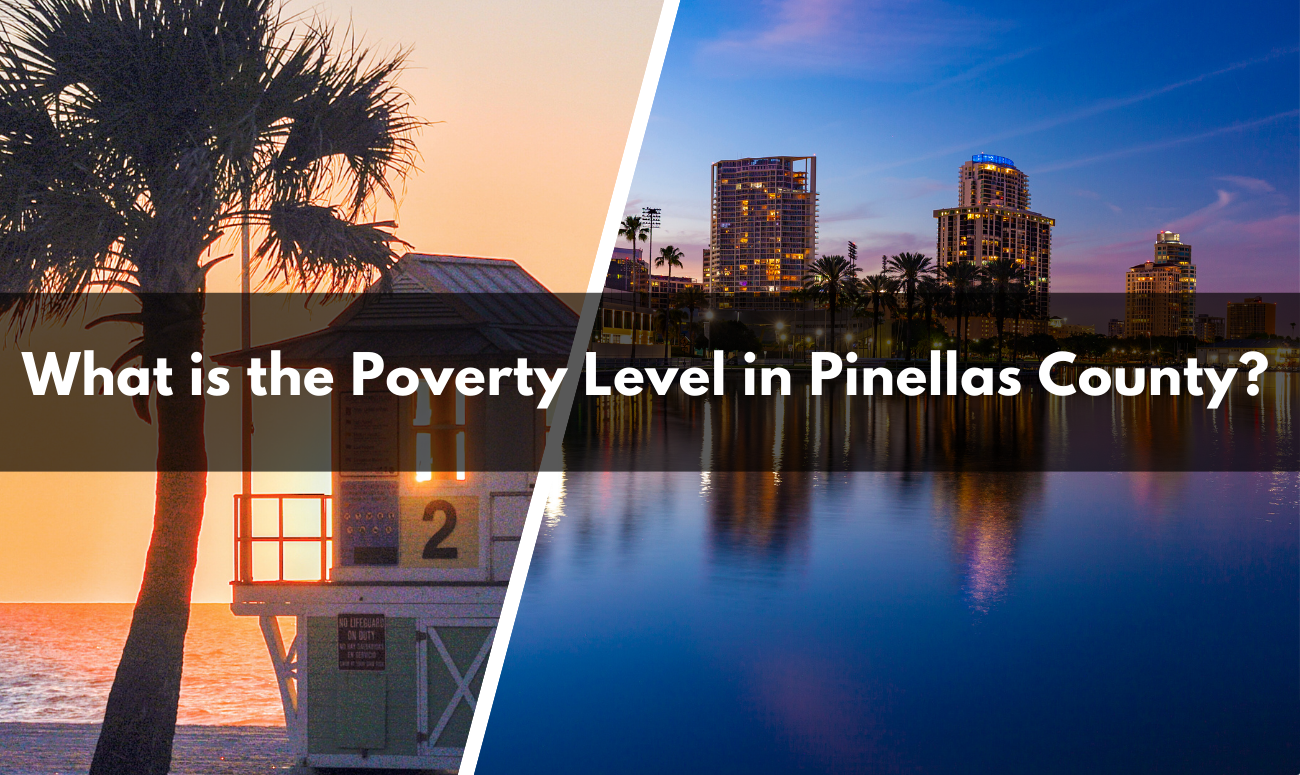What is the Poverty Level in Pinellas County? An In-Depth Look
Pinellas County, Florida, with its sandy beaches, vibrant communities, and scenic waterfronts, is known for its welcoming atmosphere. However, like many places in the United States, it faces socioeconomic challenges. Understanding the poverty level in Pinellas County can illuminate the struggles certain demographics experience, particularly those in areas marked as “At-Risk Zones.” Let’s dive into the economic landscape of Pinellas County, the demographics most affected by poverty, and the county’s unique statistics compared to state and national averages.
Understanding the Poverty Level in Pinellas County
So, what is the poverty level in Pinellas County? According to recent data, 11.5% of Pinellas County’s population lives below the poverty line. This percentage, while below the national average of 12.5%, still represents a significant portion of the county’s residents who face economic hardships. For many, meeting basic needs such as housing, food, and healthcare remains a challenge.
Pinellas County’s poverty demographics reveal that females aged 75 and older have the highest poverty rate, followed by females aged 55–64 and males in the same age bracket. Aaron Hunt, Broker of Avalon Group Realty in St. Petersburg, observes, “It’s eye-opening to see how age and gender play such pivotal roles in the county’s poverty statistics. These numbers tell a story about those who often slip through the cracks of financial stability, particularly older women who may have limited income sources.”
At-Risk Zones and Poverty Concentration
To address poverty effectively, it’s essential to understand where it is most prevalent. Pinellas County has identified five “At-Risk Zones” where poverty levels are notably higher than in other areas. These areas include East Tarpon Springs, North Greenwood, Highpoint, Lealman Corridor, and South St. Petersburg. Together, these zones house an estimated 45% of Pinellas County’s low-income population.
What is the poverty level in Pinellas County’s At-Risk Zones? By targeting assistance and resources to these areas, local organizations and policymakers aim to reduce poverty and uplift these communities. Concentrated efforts in these zones could potentially alleviate the struggles faced by residents and improve overall quality of life.
Federal Poverty Level (FPL) and Local Income Guidelines
Each year, the U.S. government releases Federal Poverty Level (FPL) guidelines, setting income thresholds based on family size to determine eligibility for certain assistance programs. In 2024, these FPL figures are critical for residents as they assess their qualifications for financial aid. The FPL data is essential for understanding what the poverty level in Pinellas County means in terms of dollars and cents.
For example, a single individual at 100% of the FPL would earn a certain amount annually, while a family of four would have a different threshold. Knowing where their income falls relative to the FPL can help residents determine eligibility for housing subsidies, food assistance, and healthcare support, which are particularly critical in the At-Risk Zones.
Demographic Breakdown of Poverty in Pinellas County
The county’s demographics reveal additional insights into poverty. For instance, the 2022 census data notes that Pinellas County has a population of approximately 960,000, with a median age of 48.8 and a median household income of $66,406. These figures highlight a community with a larger share of older adults compared to other regions.
What is the poverty level in Pinellas County’s elderly population? Among seniors aged 65 and older, about 13% live below the poverty line. Aaron Hunt comments, “The poverty rate among our older residents is concerning. Many seniors live on fixed incomes, and with rising costs, they struggle to maintain a stable, healthy lifestyle.”
Child Poverty Rates
Child poverty is another critical issue in Pinellas County, though rates here are similar to state averages. In the county, 15% of children under the age of 18 live in poverty. These figures emphasize the importance of accessible resources like affordable education, nutritious food, and healthcare to support these young residents.
Socioeconomic Profile of Pinellas County
In addition to poverty levels, the county’s socio-economic profile reveals other factors affecting residents. The five largest ethnic groups in Pinellas County are White (Non-Hispanic) at 72.4%, Black or African American (Non-Hispanic) at 9.83%, White (Hispanic) at 4.48%, Two or More Races (Hispanic) at 3.89%, and Asian (Non-Hispanic) at 3.48%.
Interestingly, what is the poverty level in Pinellas County among different ethnic groups? While this data isn’t always broken down by ethnicity, we know that minority groups often face heightened economic challenges. Focused community programs that target these groups can make a significant difference.
Housing and Economic Growth in Pinellas County
The real estate landscape also provides insight into the county’s economic well-being. In 2022, the median property value in Pinellas County was $284,300, with a 69% homeownership rate. However, while homeownership is generally viewed as a marker of economic stability, many residents struggle with the high cost of living. Pinellas County has experienced notable economic growth, with a median income increase of nearly 10% from 2021 to 2022.
Yet, housing affordability remains a concern for many, especially in At-Risk Zones. Aaron Hunt notes, “While real estate values have gone up, so have rents and the cost of living. It’s crucial to balance these rising costs with accessible housing solutions to prevent further poverty in our communities.”
Education and Employment
Pinellas County is home to educational institutions such as St. Petersburg College and the Ultimate Medical Academy, which contribute to the local economy. In 2022, the Ultimate Medical Academy awarded 7,575 degrees, while St. Petersburg College awarded over 6,400. Higher education can lead to better job opportunities and economic mobility, which is essential in reducing poverty.
Moreover, employment statistics show that most residents drive alone to work, with an average commute time of 24.7 minutes. For those in low-income brackets, commuting costs add a layer of financial strain. Expanding accessible public transportation options could ease the financial burden for many residents.
Looking Ahead: Reducing Poverty in Pinellas County
Understanding what the poverty level in Pinellas County entails requires both a snapshot of current statistics and a forward-looking approach. The county’s efforts to tackle poverty through focused support in At-Risk Zones and community programs are positive steps, but there is still work to be done.
A comprehensive plan to address poverty could include:
- Affordable Housing Initiatives: Providing affordable housing options in high-cost areas would help lower the financial burden for low-income families.
- Expanded Healthcare Services: Access to affordable healthcare, especially for seniors and children, is critical in addressing poverty.
- Economic Empowerment Programs: Offering job training and skill development can equip residents with tools to secure higher-paying jobs.
Aaron Hunt adds, “Our community has the potential to thrive if we address the poverty issues head-on. It’s not just about statistics—it’s about ensuring every resident has the opportunity to lead a fulfilling life.”
Community Support and Resources: Tackling Poverty in Pinellas County
In Pinellas County, a range of community programs and support initiatives is actively working to address poverty-related challenges, promote equity, and improve quality of life for all residents. With high poverty levels affecting certain areas more acutely, local organizations, nonprofits, and government agencies collaborate to offer resources specifically geared towards providing relief and creating new opportunities. These programs aim to address urgent needs, including housing, food insecurity, employment, healthcare, and education, while fostering resilience and long-term economic stability among vulnerable populations. Here’s a closer look at some of these impactful initiatives:
1. Housing Assistance Programs
Housing stability is a critical factor in alleviating poverty, especially in regions where rent and housing costs have steadily increased. Pinellas County and local cities, including Clearwater and St. Petersburg, provide multiple housing assistance programs designed to support low-income families, seniors, and individuals facing housing insecurity.
One of the key programs, the Pinellas County Housing Authority (PCHA), offers subsidized housing options to qualified residents, focusing on both short-term relief and long-term housing solutions. The PCHA also collaborates with local developers to create affordable housing units and rental assistance programs through federal funding initiatives like the Housing Choice Voucher Program (Section 8). Additionally, nonprofits such as Habitat for Humanity work within the county to build affordable homes, allowing families to gain homeownership opportunities through sustainable financing options.
2. Food Security and Nutritional Support
Food insecurity remains a pressing concern within high-poverty areas in Pinellas County. Local food banks, pantries, and nutritional support programs are essential in ensuring access to healthy meals for families in need. Organizations such as Feeding Tampa Bay and RCS Pinellas distribute food across multiple locations and partner with community centers to provide nutritious options for children, seniors, and underserved communities.
School districts and youth programs also play a significant role in addressing food insecurity. For example, the Pinellas County Schools’ Summer BreakSpot Program provides free meals to students during summer months when school meals are not available, helping to bridge the nutrition gap for families who rely on school-based programs. Additionally, mobile pantries, organized by groups like St. Pete Free Clinic, deliver fresh produce and other groceries to at-risk areas, enhancing accessibility for those without reliable transportation.
3. Employment and Job Training Initiatives
Addressing unemployment and underemployment is central to reducing poverty in Pinellas County. The CareerSource Pinellas organization offers job training programs, career counseling, and placement services tailored to local economic demands. These services provide residents with essential skills, allowing them to access better employment opportunities and higher wages.
The Youth Employment Program targets young adults aged 16 to 24, many of whom come from lower-income families. Through mentorship, internship placements, and professional skills workshops, participants gain hands-on experience in various fields, ranging from healthcare to information technology. The focus on young adults is especially important, as stable employment early on can significantly improve economic outcomes over a lifetime, reducing the likelihood of poverty across generations.
4. Healthcare Access and Wellness Services
Lack of access to healthcare can perpetuate poverty, as health issues often contribute to reduced earning capacity and increased financial strain. Fortunately, several healthcare organizations in Pinellas County offer low-cost or free medical services to uninsured and low-income individuals.
Community Health Centers of Pinellas (CHCP) operates clinics throughout the county, providing primary care, dental services, and behavioral health support. These centers are crucial for those who may otherwise forego necessary medical care due to cost. The Florida Department of Health in Pinellas County also provides family planning services, immunizations, and disease prevention programs to support public health in impoverished communities.
Additionally, mental health resources, such as those provided by Suncoast Center Inc., offer counseling and support services for those dealing with trauma, addiction, and other challenges. By focusing on both physical and mental health, these programs contribute to a holistic approach to well-being, which is essential in helping individuals and families overcome obstacles associated with poverty.
5. Educational Support and Early Childhood Programs
Educational attainment has long been recognized as a powerful tool in the fight against poverty. In Pinellas County, initiatives like Head Start and Early Head Start target young children from low-income families, ensuring access to quality early childhood education, healthcare, and family support services. These programs provide a strong foundation for academic success, helping to bridge the achievement gap that often exists between socioeconomic groups.
For older students, Pinellas County Schools offers the Promise Time Extended Learning Program, which provides tutoring, homework assistance, and after-school enrichment activities. These programs are particularly beneficial in areas with higher poverty rates, where families may lack resources for private tutoring or extracurricular opportunities. By supporting students in these critical years, the county is helping to set them on a path toward high school graduation, postsecondary education, and stable careers.
6. Community-Based Financial Literacy and Support
Understanding and managing finances can be challenging, especially for families struggling to make ends meet. In response, organizations in Pinellas County have developed financial literacy programs to equip residents with the knowledge and tools to improve their financial situations.
The United Way Suncoast offers free tax preparation assistance, budget coaching, and financial workshops to empower residents to make informed financial decisions. Additionally, the Family Service Centers provide debt counseling, credit repair guidance, and savings plans to help families move toward economic independence. Such programs are vital in breaking the cycle of poverty, as they provide individuals with the skills necessary to achieve long-term financial security.
7. Community Engagement and Support Networks
The power of community cannot be understated, especially in challenging times. Local nonprofits, churches, and volunteer groups in Pinellas County foster a strong network of support for residents in need. Programs such as the Pinellas County Volunteer Services initiative connect residents with community projects, helping to strengthen neighborhoods and create a sense of unity. Community centers in high-poverty areas, including the Childs Park Community Center and North Greenwood Recreation Center, serve as hubs for education, wellness, and social programs, creating safe and supportive environments for residents.
Conclusion
Through these dedicated resources, Pinellas County demonstrates a commitment to reducing poverty and enhancing the lives of its residents. Each program, from housing assistance to educational support, represents a step toward a more equitable community where individuals have the resources and opportunities they need to thrive. With these collaborative efforts in place, there is hope that Pinellas County can continue making strides toward alleviating poverty and improving the quality of life for all.
Final Thoughts: What is the Poverty Level in Pinellas County?
Pinellas County is a beautiful place to live, work, and raise a family, yet poverty remains a reality for thousands of residents. Addressing this issue requires a multifaceted approach that considers age, ethnicity, gender, and geographical location.
By understanding what the poverty level in Pinellas County truly signifies, we can foster a supportive environment where every resident has access to basic necessities and opportunities for growth. Reducing poverty isn’t just about lowering percentages; it’s about enriching lives and building a community where everyone can succeed.
Building a Brighter Future for Pinellas County
As Pinellas County continues to grow, addressing poverty and supporting vulnerable populations remain essential for building a vibrant, resilient community. Through dedicated resources, community programs, and collaborative efforts, the county is making strides in creating a more inclusive and supportive environment for everyone. Whether through housing assistance, healthcare access, or job training programs, each initiative plays a crucial role in lifting individuals and families toward a brighter future.
At Avalon Group Realty, we’re committed to helping residents and future homeowners in St. Petersburg and across Pinellas County find the best housing options to suit their needs. Understanding the local market, the unique neighborhoods, and the resources available is key to making informed decisions about where to live and invest in the Tampa Bay area. Whether you’re buying, selling, or looking to understand how to navigate the local real estate market, we’re here to guide you every step of the way.
For personalized real estate assistance, reach out to Aaron Hunt, Broker at Avalon Group Realty, who can provide expert guidance and insights tailored to your needs. Contact us at 727-262-7920 or visit our website at AvalonGroupRealtyTampaBay.com. Let’s work together to find the perfect place for you in Pinellas County!




